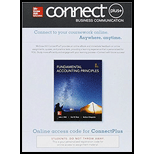
Connect 2-Semester Access Card for Fundamental Accounting Principles
22nd Edition
ISBN: 9780077632755
Author: John Wild
Publisher: McGraw-Hill Education
expand_more
expand_more
format_list_bulleted
Question
Chapter 17, Problem 15DQ
To determine
Concept Introduction:
Equity ratio: The equity ratio is calculated by dividing total shareholder’s equity by its total assets. It measures the ratio of shareholder’s equity with the total assets of the business.
It is calculated as under −
To compute:
Equity ratio of Google for the year ended on −
- December 31, 2013
- December 31, 2012
Expert Solution & Answer
Want to see the full answer?
Check out a sample textbook solution
Students have asked these similar questions
Please provide the correct answer with general accounting question
Please provide the answer to this general accounting question using the right approach.
A trial balance includes:A. Only revenue and expense accountsB. All accounts with balancesC. Only permanent accountsD. Only assets and liabilities
Chapter 17 Solutions
Connect 2-Semester Access Card for Fundamental Accounting Principles
Ch. 17 - Prob. 1DQCh. 17 - What is the difference between comparative...Ch. 17 - Prob. 3DQCh. 17 - Prob. 4DQCh. 17 - Prob. 5DQCh. 17 - Prob. 6DQCh. 17 - Prob. 7DQCh. 17 - Prob. 8DQCh. 17 - Prob. 9DQCh. 17 - How does inventory turnover provide information...
Ch. 17 - What ratios would you compute to evaluate...Ch. 17 - Why would a company’s return on total assets be...Ch. 17 - Prob. 13DQCh. 17 - Prob. 14DQCh. 17 - Prob. 15DQCh. 17 - Prob. 16DQCh. 17 - Prob. 17DQCh. 17 - Prob. 1QSCh. 17 - Prob. 2QSCh. 17 - Prob. 3QSCh. 17 - Prob. 4QSCh. 17 - Refer to the information in QS17-4. Use that...Ch. 17 - Prob. 6QSCh. 17 - Prob. 7QSCh. 17 - Prob. 8QSCh. 17 - Prob. 9QSCh. 17 - Prob. 1ECh. 17 - Exercise 17-2
Identifying financial...Ch. 17 - Prob. 3ECh. 17 - Prob. 4ECh. 17 - Prob. 5ECh. 17 - Prob. 6ECh. 17 - Prob. 7ECh. 17 - Prob. 8ECh. 17 - Prob. 9ECh. 17 - Prob. 10ECh. 17 - Prob. 11ECh. 17 - Prob. 12ECh. 17 - Prob. 13ECh. 17 - Prob. 14ECh. 17 - Prob. 15ECh. 17 - Prob. 1APSACh. 17 - Prob. 2APSACh. 17 - Prob. 3APSACh. 17 - Prob. 4APSACh. 17 - Prob. 5APSACh. 17 - Prob. 6APSACh. 17 - Prob. 1BPSBCh. 17 - Prob. 2BPSBCh. 17 - Prob. 3BPSBCh. 17 - Prob. 4BPSBCh. 17 - Prob. 5BPSBCh. 17 - Prob. 6BPSBCh. 17 - Prob. 17SPCh. 17 - Prob. 1BTNCh. 17 - Prob. 2BTNCh. 17 - Prob. 3BTNCh. 17 - Prob. 4BTNCh. 17 - Prob. 5BTNCh. 17 - Prob. 6BTNCh. 17 - Prob. 7BTNCh. 17 - Prob. 8BTNCh. 17 - Prob. 9BTN
Knowledge Booster
Learn more about
Need a deep-dive on the concept behind this application? Look no further. Learn more about this topic, accounting and related others by exploring similar questions and additional content below.Similar questions
- The matching principle helps ensure:A. Revenues are equal to expensesB. Revenues and related expenses are recorded in the same periodC. Cash is matched to liabilitiesD. Accounts match physical inventoryneed helparrow_forwardThe matching principle helps ensure:A. Revenues are equal to expensesB. Revenues and related expenses are recorded in the same periodC. Cash is matched to liabilitiesD. Accounts match physical inventoryarrow_forwardCan you solve this general accounting problemarrow_forward
- I need help ! A trial balance includes:A. Only revenue and expense accountsB. All accounts with balancesC. Only permanent accountsD. Only assets and liabilitiesarrow_forwardAccounting question pleasearrow_forwardNo Ai A trial balance includes:A. Only revenue and expense accountsB. All accounts with balancesC. Only permanent accountsD. Only assets and liabilitiesarrow_forward
- Which account is increased with a credit?A. CashB. Salaries ExpenseC. Accounts ReceivableD. Service Revenue need helparrow_forwardNo AI A trial balance includes:A. Only revenue and expense accountsB. All accounts with balancesC. Only permanent accountsD. Only assets and liabilitiesarrow_forwardI need help with this general accounting problem using proper accounting guidelinesarrow_forward
- Hello Needed Answer of Financial Accounting Question with Correct Methodarrow_forwardNo AI Which account is increased with a credit?A. CashB. Salaries ExpenseC. Accounts ReceivableD. Service Revenuearrow_forwardWhich account is increased with a credit?A. CashB. Salaries ExpenseC. Accounts ReceivableD. Service Revenuearrow_forward
arrow_back_ios
SEE MORE QUESTIONS
arrow_forward_ios
Recommended textbooks for you

 AccountingAccountingISBN:9781337272094Author:WARREN, Carl S., Reeve, James M., Duchac, Jonathan E.Publisher:Cengage Learning,
AccountingAccountingISBN:9781337272094Author:WARREN, Carl S., Reeve, James M., Duchac, Jonathan E.Publisher:Cengage Learning, Accounting Information SystemsAccountingISBN:9781337619202Author:Hall, James A.Publisher:Cengage Learning,
Accounting Information SystemsAccountingISBN:9781337619202Author:Hall, James A.Publisher:Cengage Learning, Horngren's Cost Accounting: A Managerial Emphasis...AccountingISBN:9780134475585Author:Srikant M. Datar, Madhav V. RajanPublisher:PEARSON
Horngren's Cost Accounting: A Managerial Emphasis...AccountingISBN:9780134475585Author:Srikant M. Datar, Madhav V. RajanPublisher:PEARSON Intermediate AccountingAccountingISBN:9781259722660Author:J. David Spiceland, Mark W. Nelson, Wayne M ThomasPublisher:McGraw-Hill Education
Intermediate AccountingAccountingISBN:9781259722660Author:J. David Spiceland, Mark W. Nelson, Wayne M ThomasPublisher:McGraw-Hill Education Financial and Managerial AccountingAccountingISBN:9781259726705Author:John J Wild, Ken W. Shaw, Barbara Chiappetta Fundamental Accounting PrinciplesPublisher:McGraw-Hill Education
Financial and Managerial AccountingAccountingISBN:9781259726705Author:John J Wild, Ken W. Shaw, Barbara Chiappetta Fundamental Accounting PrinciplesPublisher:McGraw-Hill Education


Accounting
Accounting
ISBN:9781337272094
Author:WARREN, Carl S., Reeve, James M., Duchac, Jonathan E.
Publisher:Cengage Learning,

Accounting Information Systems
Accounting
ISBN:9781337619202
Author:Hall, James A.
Publisher:Cengage Learning,

Horngren's Cost Accounting: A Managerial Emphasis...
Accounting
ISBN:9780134475585
Author:Srikant M. Datar, Madhav V. Rajan
Publisher:PEARSON

Intermediate Accounting
Accounting
ISBN:9781259722660
Author:J. David Spiceland, Mark W. Nelson, Wayne M Thomas
Publisher:McGraw-Hill Education

Financial and Managerial Accounting
Accounting
ISBN:9781259726705
Author:John J Wild, Ken W. Shaw, Barbara Chiappetta Fundamental Accounting Principles
Publisher:McGraw-Hill Education
Financial ratio analysis; Author: The Finance Storyteller;https://www.youtube.com/watch?v=MTq7HuvoGck;License: Standard Youtube License